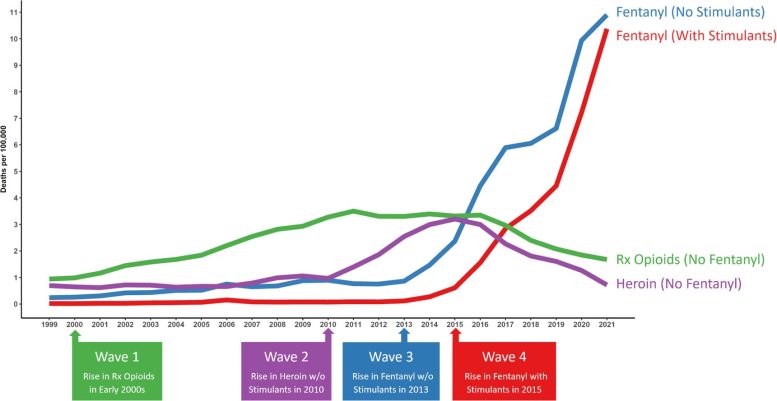
UCLA research identifies a 50-fold increase in US overdose deaths involving fentanyl and stimulants since 2010, marking a concerning ‘fourth wave’ in the opioid crisis. The rise in polysubstance use presents unique healthcare challenges, with racial minorities disproportionately affected and regional variances in drug combinations.
The trend marks the fourth wave in the US overdose crisis, which began with prescription opioid deaths in the early 2000s and has since continued with other drugs.
New UCLA-led research has found that the proportion of US overdose deaths involving both fentanyl and stimulants has increased more than 50-fold since 2010, from 0.6% (235 deaths) in 2010 to 32.3% (34,429 deaths) in 2021.
By 2021, stimulants such as cocaine and methamphetamine had become the most common drug class found in fentanyl-involved overdoses in every US state. This rise in fentanyl/stimulant fatalities constitutes the ‘fourth wave’ in the US’s long-running opioid overdose crisis –the death toll of which continues to rise precipitously.
Experts Weigh In
“We’re now seeing that the use of fentanyl together with stimulants is rapidly becoming the dominant force in the US overdose crisis,” said lead author Joseph Friedman, an addiction researcher at the David Geffen School of Medicine at UCLA.
“Fentanyl has ushered in a polysubstance overdose crisis, meaning that people are mixing fentanyl with other drugs, like stimulants, but also countless other synthetic substances. This poses many health risks and new challenges for healthcare providers. We have data and medical expertise about treating opioid use disorders, but comparatively little experience with the combination of opioids and stimulants together, or opioids mixed with other drugs. This makes it hard to stabilize people medically who are withdrawing from polysubstance use.”
The findings were published on September 13 in the peer-reviewed journal Addiction.

A simplified schema of the four waves of the US overdose mortality crisis. Waves 1 and 2 include deaths involving commonly prescribed opioids, and heroin, respectively, but excluding fentanyl co-involved deaths. Wave 3 and Wave 4 show fentanyl deaths not involving, and involving, stimulants respectively as distinct trends. Data from CDC WONDER. Credit: Friedman and Shover, 2023, doi: 10.1111/add.16318
Chronology of the Opioid Crisis
The analysis illustrates how the US opioid crisis began with an increase in deaths from prescription opioids (wave 1) in the early 2000s and heroin (wave 2) in 2010. Around 2013, an increase in fentanyl overdoses signaled the third wave. The fourth wave – fentanyl overdoses with stimulants – began in 2015 and continues to grow.
Further complicating matters is that people consuming multiple substances may also be at increased risk of overdose, and many substances being mixed with fentanyl are not responsive to naloxone, the antidote to an opioid overdose.
Demographic and Geographical Trends
The authors also found that fentanyl/stimulant overdose deaths disproportionately affect racial/ethnic minority communities in the US, including Black and African American people and Native American people. For instance, in 2021, the prevalence of stimulant involvement in fentanyl overdose deaths was 73% among 65 to 74-year-old Non-Hispanic Black or African-American women living in the western US and 69% among 55 to 65-year-old Black or African-American men living in the same area. The rate among the general US population in 2021 was 49%.
There are also geographical patterns to fentanyl/stimulant use. In the northeast US, fentanyl tends to be combined with cocaine; in the southern and western US, it appears most commonly with methamphetamine.
“We suspect this pattern reflects the rising availability of, and preference for, low-cost, high-purity methamphetamine throughout the US, and the fact that the Northeast has a well-entrenched pattern of illicit cocaine use that has so far resisted the complete takeover by methamphetamine seen elsewhere in the country,” Friedman said.
Reference: “Charting the fourth wave: Geographic, temporal, race/ethnicity and demographic trends in polysubstance fentanyl overdose deaths in the United States, 2010–2021” by Joseph Friedman and Chelsea L. Shover, 13 September 2023, Addiction.
DOI: 10.1111/add.16318
The study was funded by the UCLA Medical Scientist Training Program (National Institute of General Medical Sciences training grant GM008042) and the National Institute on Drug Abuse at the National Institutes of Health (K01DA050771). The content is solely the responsibility of the authors and does not necessarily represent the official views of the National Institutes of Health.









A more positive way to look at this is that it weeds the herd of humanity of weaker members.
Jojo, how can it be that it allegedly “weeds the herd of humanity of weaker members” yet you are still here and commenting? Why has it not “weeded” you from our herd? Based on your comment there is no doubt that you excessively lacking in humanity. By definition, the “weaker members” of humanity would be those individuals with little to zero humanity. Couple that with your complete lack of both sympathy and empathy, as exemplified by your consideration of this epidemic in “more positive” terms equates to you being not just a weaker member of humanity but a well qualified all around s***ty person. If fentanyl laced simulants didn’t work on you, then we definitely need to find a better method to “weed out the riff-raff” here.
It’s not Jojo at fault here, but the Joe who runs “Traitor Joe’s” & the creeps who instruct him. To reference LOTR, he always does what his “Sharkey” says!